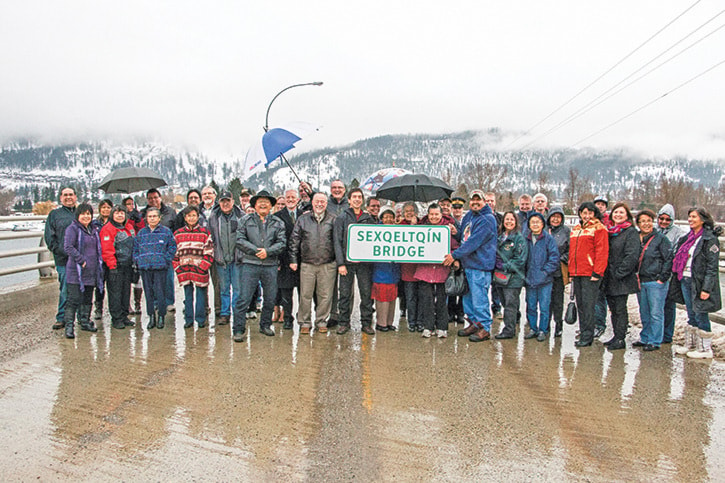The naming of a bridge spanning the South Thompson River Friday was both a physical and a symbolic act.
On Jan. 23, the chief and council of the Adams Lake Indian Band, the Chase mayor and councillors, leaders and elders from around the area, as well as provincial and federal government representatives, gathered for the adding of a Secwepemc name to the bridge known also as the Pine Street bridge.
The new name is the Sexqeltqin Bridge, meaning ‘the head of the river.’
Band councillor Cliff Arnouse pointed out that the bridge is not just about the structure anymore, but building bridges to communities, “sharing ideas, building partnerships.”
Band councillor Henry Anthony explained the band and other government representatives met in January 2013 and talked about how to work together.
“I put out the idea – if we’re serious about working together, let’s put a Shuswap name on the bridge.”
He said everyone around the table agreed, so a bridge-naming contest was held, with strong participation from elders.
Arnouse noted the name was chosen because the bridge is at the beginning of the river.
“They chose it because it indicates the area, it indicates the beginning of the river, and also there are many, many other name places the Secwepemc have all over the territory – there are name places we’re just starting to bring out.”
He notes the bridge is not just the Pine Street bridge.

“Our people have lived here for hundreds of years, thousands of years,” Arnouse said, referring to an archeological find at Hoffman’s Bluff dating back about 10,000 years. “We have name places all over the territory – this is just one of them.”
He said there were pit houses where the bridge was built and there remains concern about the loss of artifacts there.
Overall, there are good and bad things about the bridge and the increased traffic it brings, he says.
The effects on the area’s plants and animals from increased traffic and all the people it brings are a concern, but, at the same time, it’s good for many people – it’s good for the band’s agriculture, for use of its facilities, for tourism.
“It works both ways; it’s good and bad.”
Anthony notes there is a tangible relationship when people cross the bridge and meet with their neighbours downtown. He said having a name on the bridge and sharing the stories behind it makes building relationships easier.
He points out: “The Adams Lake Indian Band have community and staff that work on both sides of river. School buses go back and forth on the bridge. Business relationships, agricultural and silvicultural programs – they all have to cross in order to meet. This is a way of building a better relationship. Adams Lake is moving forward, the community, it’s progressive...”
He said he’s heard from university students and young parents who are getting their identity back on the land.
“I believe this is one of the ways of showing who we are and our language... So when our students, our young parents come home with their kids, they can say, ‘Hey, this is our bridge, who we are.’”
